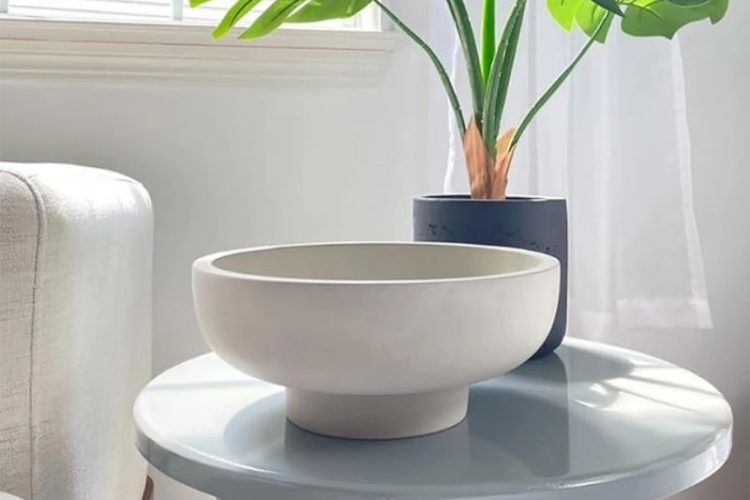Concrete fruit bowls are quickly gaining popularity as a trend in modern home decor, particularly among those who appreciate sustainable and handmade home accessories. As consumers continue to embrace eco-conscious lifestyles, global demand for handcrafted concrete products has surged, creating new opportunities for importers and retailers.
Vietnam has emerged as one of the world’s leading exporters of pottery, ceramics, and concrete home handicrafts. However, importing these products can be challenging for businesses unfamiliar with Vietnam’s sourcing landscape and export procedures.
With this in mind, this guide is for anyone looking to buy concrete fruit bowls from Vietnam and bring them to their own market. It provides a clear, step-by-step overview of how to import concrete fruit bowls from Vietnam, from finding reliable suppliers, handling customs and shipping, and complying with local internal regulations.
Why Vietnam is becoming a global source for concrete fruit bowls
In 2023, Vietnam exported over $3 billion worth of pottery, ceramic, and concrete products to major markets such as the United States, Japan, the European Union, and several Middle Eastern countries. Vietnamese pottery and concrete handicrafts are renowned for their exceptional quality and distinctive designs.
Vietnam has thousands of manufacturers supported by highly skilled artisans. Many of these manufacturers in Vietnam have invested in modern production equipment and automated machinery to enhance product quality and production efficiency. Some have also obtained ISO 9001 certification for their quality management systems.
In particular, Vietnam stands out for its wide range of high-quality handicrafts at competitive prices. Among developing markets in the region, Vietnam is a clear leader in low-cost manufacturing and sourcing. In 2020, Vietnam’s average manufacturing labor costs were around USD 2.99 per hour, roughly half of China’s USD 6.50 and about 40 percent of that in Thailand and the Philippines.
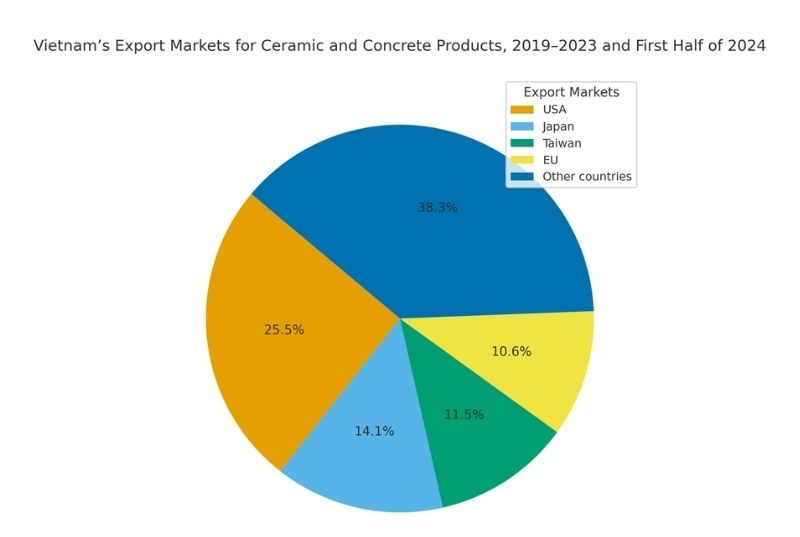
Source: General Department of Vietnam Customs
How to import concrete fruit bowls from Vietnam
Importing concrete fruit bowls from Vietnam can be a profitable venture, especially as global demand for sustainable and handcrafted home decor continues to rise. However, to ensure a smooth and cost-effective process, it is important for you to clearly understand the country’s import procedures.
Finding a local partner
Working with a local partner is one of the most effective ways to simplify sourcing and ensure smooth operations in Vietnam. A trusted partner can help bridge language barriers, navigate local regulations, and manage supplier relationships more efficiently.
Establishing a local presence, either through a representative office or a trading company, can be a highly effective long-term solution.
- Partnering with a Vietnamese trading company is a fast and low-risk way to export from Vietnam. In this model, the trading company manages all export procedures on your behalf. This approach allows foreign firms to bypass administrative hurdles and complex local regulations. However, it also limits visibility and control over the production and export process, as all operations are managed through an intermediary.
- Working with sourcing agents or independent consultants offers a balanced approach between full outsourcing and complete in-house management. These can assist with supplier identification, price negotiation, quality control, and logistics coordination. This method gives importers more flexibility and transparency than relying solely on trading companies, but it requires careful due diligence to ensure reliability.
- Setting up your own trading company is suitable for companies planning long-term sourcing from Vietnam, offers the highest level of control and independence. The main drawback of setting up your own trading company in Vietnam is the high cost and complexity of establishment. It requires significant capital investment, detailed legal registration, and compliance with local tax and labor regulations.

Identify reliable suppliers
Choosing the right supplier is nearly the most important step in sourcing products from Vietnam because it directly affects product quality, delivery time, and overall business success. Reliable suppliers ensure consistency, transparency, and compliance with export standards, helping you avoid costly delays or quality issues.
Once you have a list of potential suppliers, you should verify several key details before finalizing your supplier to ensure that the partnership is reliable and sustainable.
- Checking the supplier’s certifications, such as ISO9001, CE, or SGS testing reports, which indicate compliance with international quality standards.
- Review their references and reputation by asking for export history, buyer testimonials…
- Lead time and production capacity to ensure they can meet your schedule, especially during high-demand seasons.
- Material sourcing
- Customization options, if needed
- Quality control process
After verifying all supplier information, you should visit the factory in person to observe production activities and assess product quality directly. If the supplier is found online and an on-site visit is not possible, you should order product samples instead. This allows you to carefully evaluate the concrete fruit bowl’s surface texture, sealing quality, and weight consistency, ensuring the products meet your quality and design expectations before placing a bulk order.
Negotiate pricing, MOQs, and timeline
If you approve the product sample, it’s time to discuss business terms with your supplier. Please make sure all agreed-upon terms are written clearly in a formal contract, so they are legally binding and transparent.
Before signing, take time to clarify some terms in the contract
- Minimum order quantities (MOQs): For concrete fruit bowls, MOQs typically range from 200 to 500 units, depending on the factory’s capacity and level of customization.
- Payment terms: Most Vietnamese suppliers prefer 50/50 (50% deposit and 50% before shipment) or 30/70 payment terms. Always confirm the schedule and method of payment clearly in writing.
- Lead times: The average production lead time is 30 to 60 days, depending on order volume, design complexity, and material availability.
- Price Negotiation: Discuss unit pricing carefully, considering order quantity, packaging, and shipping terms. Be transparent but firm to reach a fair price that ensures both profitability and product quality.
- Penalty clauses for late delivery, defects, or non-compliance.

Choose logistics and shipping options
Once production is complete, you should carefully choose the most suitable logistics and shipping method based on your delivery timeline, order volume, and destination market.
Vietnam offers multiple transport options – by air, sea, or land – each with different costs and transit times. Working with an experienced freight forwarder or logistics partner can help you compare rates and manage customs documentation efficiently.
Where to find reliable concrete fruit bowl suppliers in Vietnam
The following methods can help you identify trustworthy Vietnamese suppliers for concrete fruit bowls and minimize sourcing risks.
Factory locations and production clusters
Vietnam has approximately 5,400 craft and traditional craft villages across the country. These villages play an important role in Vietnam’s export economy, especially in handmade and home decor products.
Below are some prominent provinces with strong production capacity:
- Binh Duong is well-known for its pottery and ceramics, which are exported to both domestic and international markets. The province is home to around 350 pottery and concrete manufacturers, with an estimated annual export value of approximately USD 50 million.
- Dong Nai: Located in southeastern Vietnam, east of Ho Chi Minh City, this province is known for producing high-quality and uniquely designed pottery and concrete products. With skilled artisans and modern production facilities, Dong Nai offers competitive manufacturing costs that attract a growing number of foreign buyers. The region has become one of Vietnam’s most active centers for home decor and export-oriented concrete production, supplying products to markets across Asia, Europe, and America.
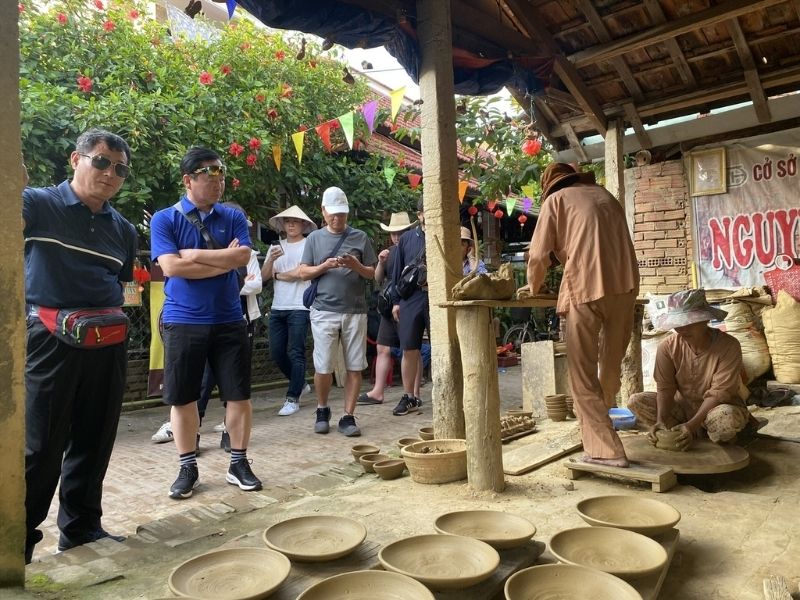
Finding source suppliers online
Besides sourcing directly from manufacturers, you can find concrete fruit bowl suppliers through different sourcing channels. Searching on Google is a quick way to discover smaller workshops and niche producers in Vietnam. This approach gives you a broad range of results, but because suppliers are not verified, it carries a higher risk of unreliable listings. Please remember to conduct due diligence, check reviews, and verify business registration before proceeding.
Moreover, you can also use trusted B2B platforms such as Alibaba. Although it is a Chinese B2B platform, it still features an impressive number of Vietnamese manufacturers producing home decor items like concrete fruit bowls. The platform allows you to browse product catalogs, request quotations, and use Trade Assurance to protect your payments and ensure order fulfillment. In addition, you can explore other platforms such as VinaSources and Kompass, which also connect buyers with verified suppliers and offer convenient tools for sourcing and communication.
By using these platforms, you can check supplier certifications, export history, and customer feedback, helping you evaluate reliability before placing an order. Using verified B2B platforms gives you greater confidence in product quality and helps reduce sourcing risks when importing concrete fruit bowls from Vietnam.
Attend trade fairs and sourcing events
Attending trade fairs and sourcing events is one of the most effective ways to find reliable manufacturers in Vietnam. Major exhibitions such as Vietnam EXPO, Vietnam Furniture Fair (VIFA) are among the most famous trade shows, showcasing a wide range of products, including electronics, machinery, handicrafts, home decoration, and household items, where you can also find concrete fruit bowl suppliers.
When attending trade fairs, you should:
- Check the exhibitor list in advance and prepare a shortlist of booths to visit.
- Prepare a checklist of key questions, such as production capacity, minimum order quantity (MOQ), lead time, material sourcing, customization options, and quality control process.
- Observe and evaluate the product samples on-site. For concrete fruit bowls, pay attention to weight consistency, surface smoothness, color uniformity, sealing quality, and overall finish.
- Exchange business cards and establish direct contact with potential suppliers.
- Follow up after the event by requesting quotations, product catalogs, and production certificates. This helps you compare suppliers objectively and make data-driven decisions.
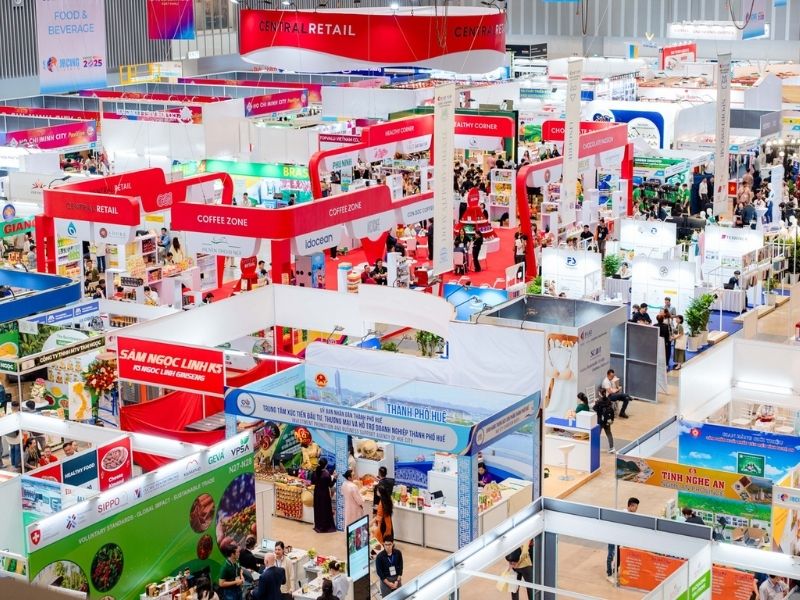
Key points you need to pay attention to while importing concrete fruit bowls from Vietnam
Here are some key points to consider when importing concrete fruit bowls from Vietnam:
Packaging, labelling, and regulatory compliance
To avoid delays or product damage during transit, you should pay close attention to packaging, labelling, and documentation. Exported goods must meet the standards of the importing country, including safety, labeling language, and material requirements.
While Vietnam does not impose extensive labelling rules for goods leaving the country, all exported products must comply with the Customs Law (2014) and the Ministry of Industry and Trade (MOIT) guidelines.
Key compliance points include:
- Labels must not misrepresent the origin, material, or nature of the goods.
- All export documents should correspond exactly with the details on the product labels, such as product codes and descriptions.
- For items also distributed within Vietnam, labeling must comply with the requirements outlined in Decree 43/2017/ND-CP on goods labeling regulations.
Taxation and free trade agreements (FTAs)
Currently, Vietnam does not impose export taxes on most manufactured goods, including furniture, home decor, and electronics. However, import taxes or duties may still apply in the destination country, depending on the product type, HS code, and applicable trade agreements. Businesses should consult with local customs brokers or trade advisors to verify these costs before shipping.
Additionally, Vietnam’s extensive network of free trade agreements (FTAs) allows exporters to reduce or eliminate tariffs if their products meet the required rules of origin.
By understanding Vietnam’s tax policies and making full use of these FTAs, exporters can lower overall costs, accelerate customs clearance, and enhance their competitiveness in global markets.
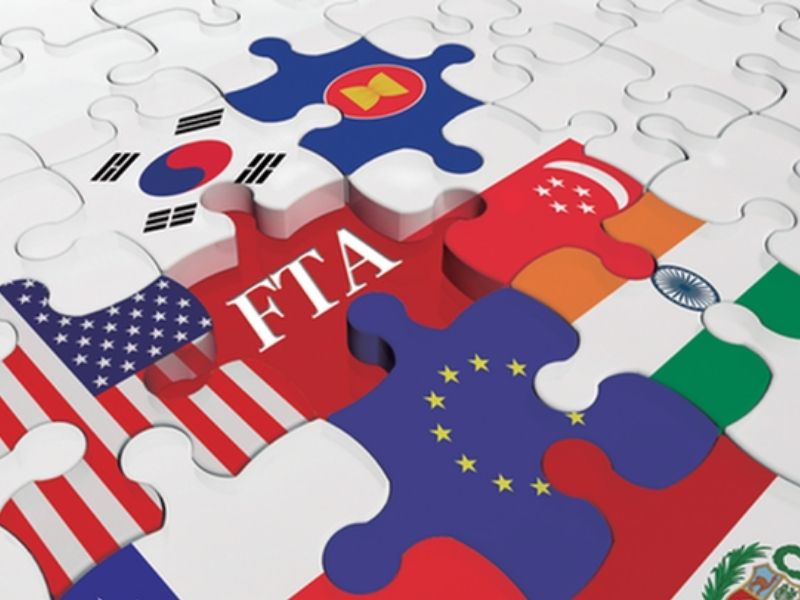
Customs procedures and clearance
Exporting from Vietnam requires completing the country’s customs clearance process, which is generally straightforward but demands careful attention to detail.
To avoid delays, ensure all documents are accurate and consistent, especially product descriptions, HS codes, and certificates. Working with experienced freight forwarders or customs brokers can help prevent common mistakes.
You should prepare key export documents to ensure smooth clearance and avoid unnecessary holdups, including:
- Commercial invoice
- Packing list
- Customs declaration
- Certificate of origin
- Bill of lading
Partnering with VinaSources for Streamlined Import Operations
Looking to source concrete fruit bowls from Vietnam? VinaSources makes it simple. As one of Vietnam’s leading B2B sourcing platforms, VinaSources connects you directly with verified and export-ready manufacturers, ensuring product quality, transparency, and smooth delivery from factory to port.
Here’s a simple step-by-step guide to ordering through VinaSources:
Step 1: Submit your request
Search for the product you need on VinaSources or send your sourcing request directly, or just tell us what you need, such as product type, specifications, quantity, target price, and delivery time.
Step 2: Receive verified supplier quotations
VinaSources will collect quotations from certified, export-ready suppliers and recommend the most suitable options based on your specific requirements.
Step 3: Confirm and place your order
Select your preferred supplier and confirm the order directly through the platform. After confirmation, the supplier will begin production according to your approved specifications and agreed terms.
Below is one of the available ready-to-export concrete fruit bowls for sale on VinaSources:
| No. | Criteria | Details |
| 1 | Dimensions | 10.5 in (L) x 10.5 in (W) x 4.25 in (H) |
| 2 | Material | Concrete |
| 3 | Weight | 7.5 pounds |
| 4 | Color | white/gray tone |
| 5 | Applications | This concrete fruit bowl provides ample space for holding a variety of fruits, while keeping your kitchen countertop neat and organized. |
| 6 | MOQ | 200 pieces |
| 7 | Lead time | 50-60 days |
| 8 | OEM / ODM | Acceptable |
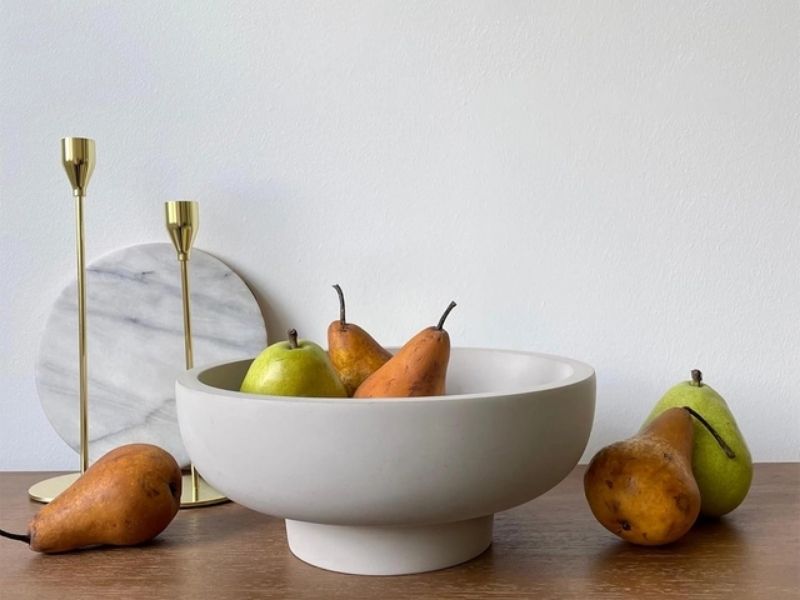
VinaSources also offers a wide selection of concrete fruit bowls in various designs, sizes, and colors to match different market preferences and styles.
If you’re looking to source concrete fruit bowls from Vietnam, please email us at [email protected]. Our services are designed to help you connect with the most reliable suppliers and simplify every step of the sourcing process.
We’ve helped buyers from all over the world build reliable sourcing partnerships in Vietnam. So don’t hesitate to get in touch and tell us what you need. We’re here to help you find trusted suppliers and bring authentic Vietnamese craftsmanship to your business.
